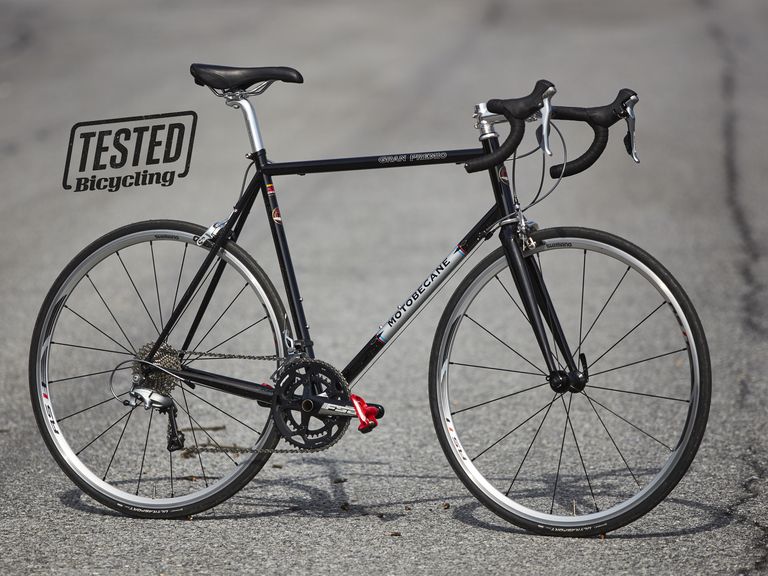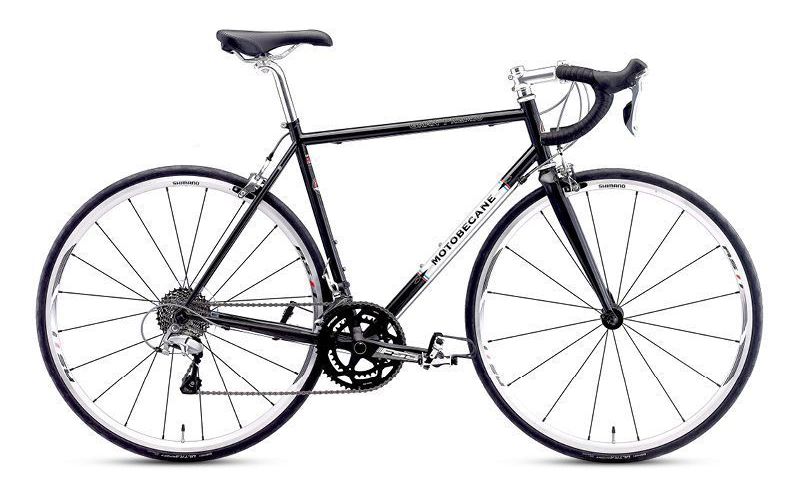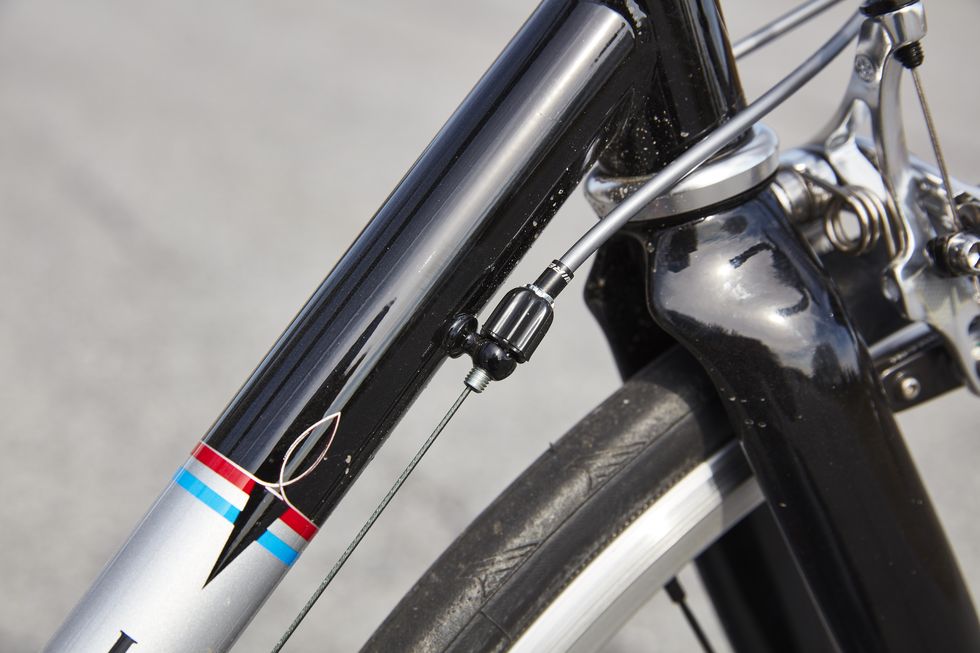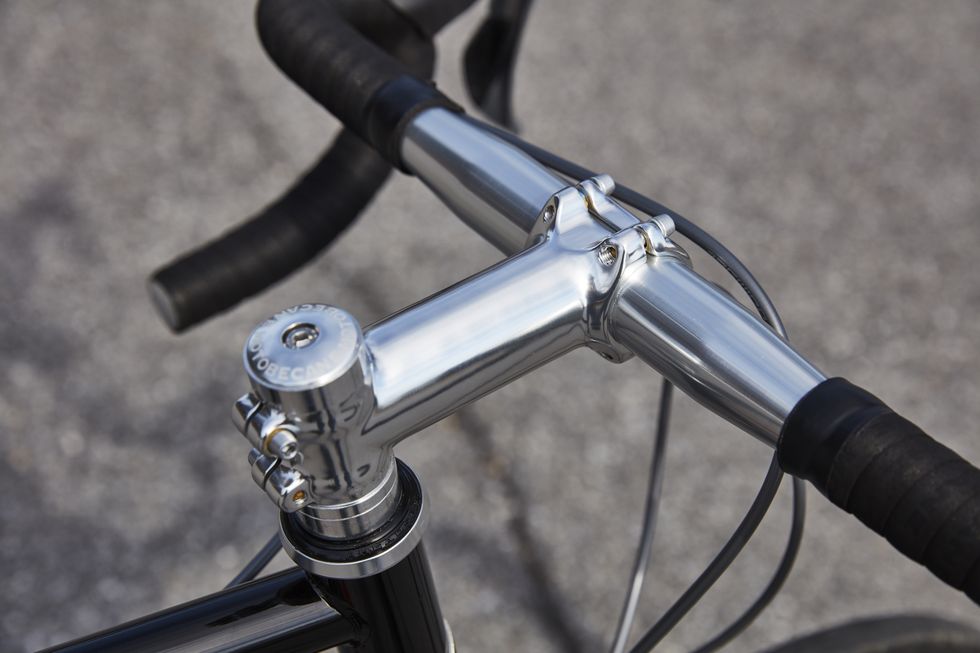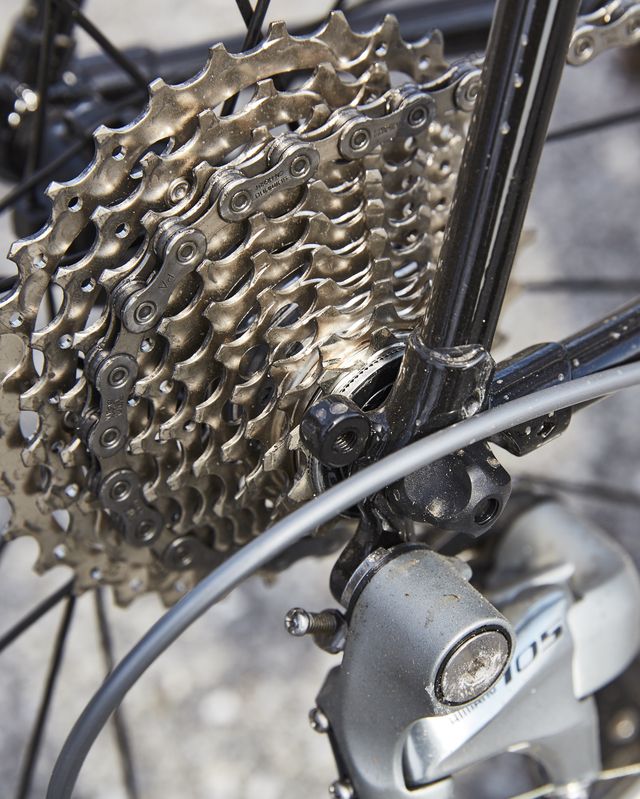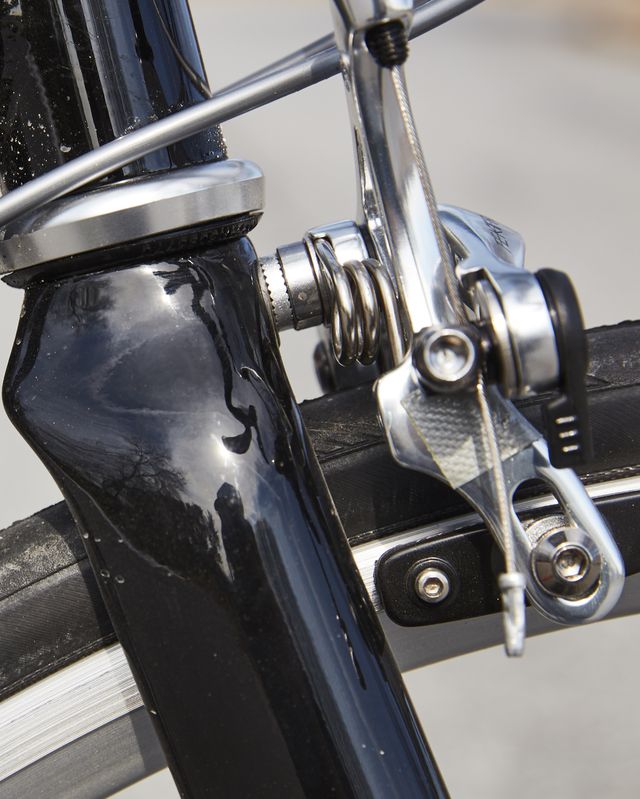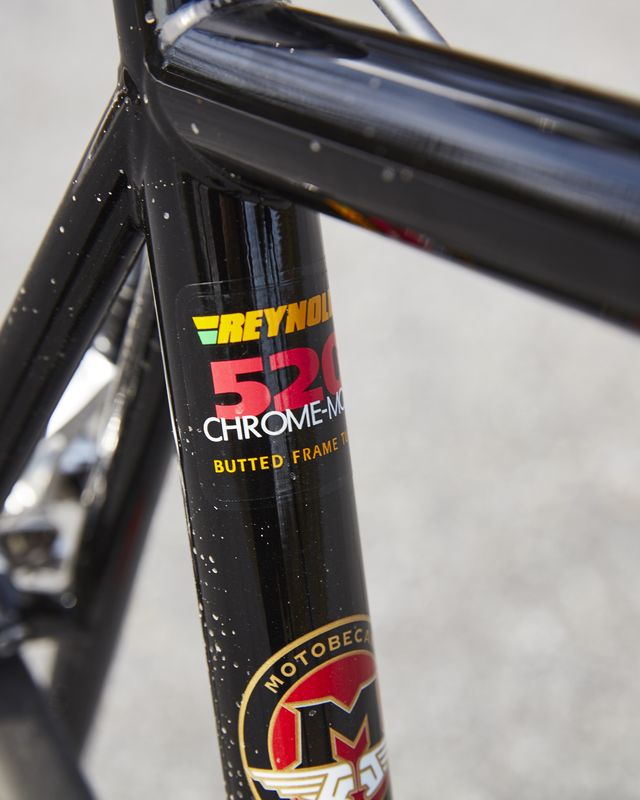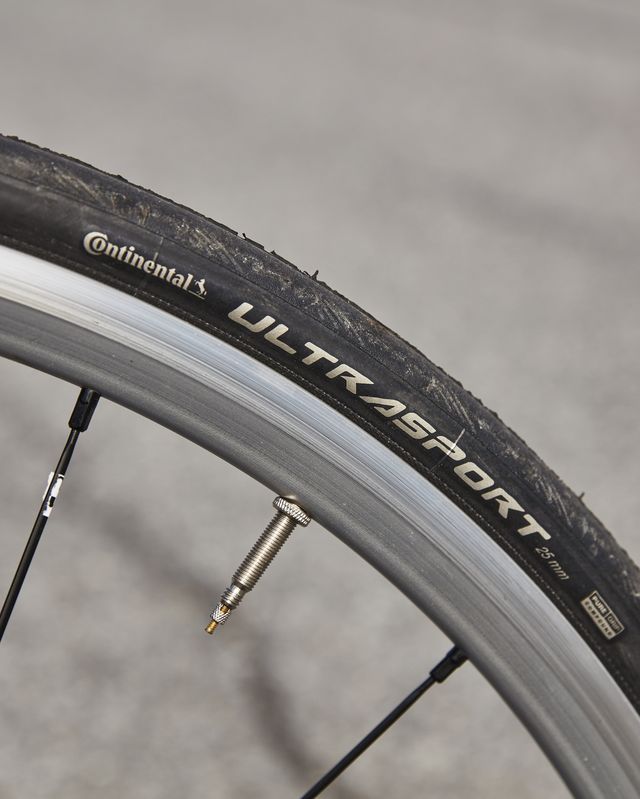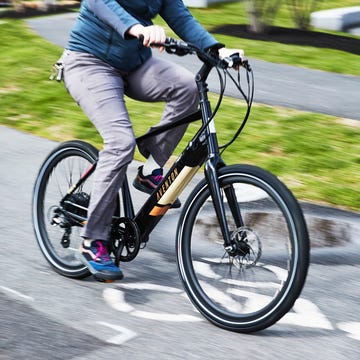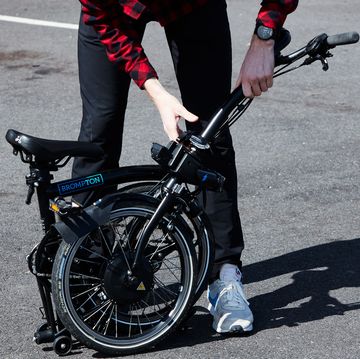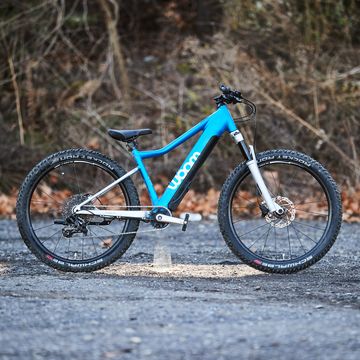The Takeaway: Aggressive handling and crisp shifting highlight this high-value roadie.
- Who Should Buy It: Anyone looking for an exciting road bike at under $1,000
- What We Love: You won’t find Shimano 105 anywhere else at this price
- Something We Don’t: The Tektro rim brakes are the opposite of good
Price: $796
Weight: 21.4 lb. (59cm)
If you’re in the market for a new, sub-$1,000 road bike and you think your only option is a bicycle from a major brand with an aluminum frame, a carbon fiber fork, and a lower-end Shimano drivetrain, you’re wrong. Allow us to elaborate: The $796 Motobecane Gran Premio Elite isn’t a new design, but the steel-framed roadie is lighter than aluminum competitors and delivers superb vibration damping. It also has a better-shifting drivetrain than rivals from Trek, Cannondale, and Specialized, and as a matter of opinion, those sporty Shimano RS11 wheels look splendid on the Motobecane’s classic steel silhouette.
In other words, the Gran Premio Elite is an excellent value proposition on paper. It’s also sold by BikesDirect, an online consumer-direct retailer, which means you won’t be able to test-ride before you buy (although you have 30 days to return it and get a full refund). Out on the roads, the ride quality from the steel frame and carbon fork makes crack-laden pavement feel a lot less jarring, and a 73.5-degree head-tube angle keeps the steering sharp. The Tektro rim brakes are underpowered, but shifting from the Shimano 105 drivetrain is fast and crisp, and that makes the Gran Premio Elite feel more expensive than it is. It’s not explosive under hard pedaling, and if that sensation of stiffness and immediate power transfer is important to you then an aluminum bike might be better. But for getting outside and enjoying the roads, the Motobecane not only looks the part, it’s also one of the smoothest-riding bikes for the money.
How Is This Bike So Cheap?
The Gran Premio Elite is affordable yet well-equipped because it capitalizes on the strategy of making old stuff good again, starting with the name. Those in the know will realize Motobécane, the storied French bike company, kicked the crankset in 1981. BikesDirect licensed the name Motobecane USA more than a decade ago and began selling bikes made by Taiwanese manufacturer Kinesis Industry Co. Ltd. (If that sounds sketchy, it’s not without precedent: Most brands use a handful of overseas manufacturers to make their bikes. Kinesis makes bikes for Diamondback, Felt, GT, and others.) So the Motobécane heritage is all marketing, but old-school chromoly steel frames are cheap, especially when you cut out the middle man. It’s not cutting-edge tech, but it’s what enables BikesDirect to sell you a road bike with a carbon fork and Shimano 105 components for less than $800.
To put that value in context, the Specialized Allez, Cannondale CAAD Optimo Claris, and Trek Domane AL 2 represent the entry-level road bikes you can buy for around $840-850 from a well-established brand. All use aluminum frames, carbon forks, and Shimano Claris drivetrains—three steps down the Shimano road hierarchy from the 105 drivetrain on the Motobecane. Cannondale and Trek list weights for their bikes in 56cm frame sizes; both are claimed to weigh roughly the same as our 59cm Gran Premio Elite, which also has a (typically heavier) steel frame. And because the 105 drivetrain has an 11-speed cassette to the Claris’s 8 speeds, the jumps between gears are tighter (on an equally geared 11-32 cassette), which means smoother shifting and smaller cadence changes.
Style: Road
Material: Steel
Fork: Motobecane straight blade carbon
Drivetrain: Shimano 105
Gearing: 50/34 crankset, 11-32 cassette
Brakes: Tektro 540 mechanical rim brakes
Wheels: Shimano RS11 aluminum
Tires: Continental Ultra Sport II, 700x25mm
Beyond the Components
The stem, seatpost, and handlebar are aluminum and badged as Motobecane. The crankset is FSA’s Gossamer. On the size 59cm bike, the 110mm stem and 175mm crank felt appropriately sized. The geometry is old-school and aggressive: There’s a steep 73.5-degree head tube angle, the seat tube angle is also 73.5 degrees, and although BikesDirect doesn’t list a reach measurement, the 585mm effective top tube length indicates a long riding position. Coupled with relatively short 405mm chainstays, the Gran Premio Elite has aggressive angles—which is not just amusing for casual cyclists, but also ideal for racers wanting a low-cost winter bike that mimics their long riding position.
Potential buyers should know that although shipping is free, you’ll have to assemble the bike yourself or pay a local shop to do it. That means mounting the handlebar and adjusting the brakes and drivetrain, so factor in the cost of assembly if you’re not comfortable doing it yourself.
Ride Impressions
If you’ve ever ridden an older steel road bike, the Gran Premio Elite will feel familiar, in that it feels solid but flexes more than modern aluminum and carbon fiber designs. That makes it compliant over rough pavement, and the ride quality is surprisingly supple for a bike running 25mm tires at 80 psi (there’s clearance for tires up to 28mm). The trade-off is you don’t get that sensation of immediacy when you stand up and mash the pedals, although at 21 pounds, the Gran Premio Elite doesn’t feel slow, either.
Descending, you’re especially reminded of why modern road bikes aren’t built in the manner of the Motobecane. The steep head tube angle means fast steering, and on a frame that’s not terribly stiff, that makes high-speed cornering a bit more lively. It responds to your inputs quickly and demands utmost concentration in the twisties; whether that’s terrifying or exhilarating is up to you. The real excitement arrives when you approach an intersection: From 45mph, I needed 100 meters to bring the bike to a halt on bone-dry pavement. The Tektro rim brakes aren’t a strong point.
That brings us to the final question: Who should buy one? Despite the brakes, the rest of the components make the Gran Premio Elite exceptional for the money, but a modern aluminum design might be a better platform for improvements if you’re thinking about getting into road racing. You can always upgrade from a Claris to a 105 drivetrain, for instance, and most racers would probably trade poor vibration damping for a stiffer frame. But for cyclists who just want an affordable road bike with an exciting ride and excellent shifting from the box, the Gran Premio Elite is without parallel.

A former Division 1 runner, Dan grew up riding fixies and mountain bikes and now reviews everything from performance running shoes to road and cross bikes, to the latest tech for runners and cyclists at Bicycling and Runner’s World.
